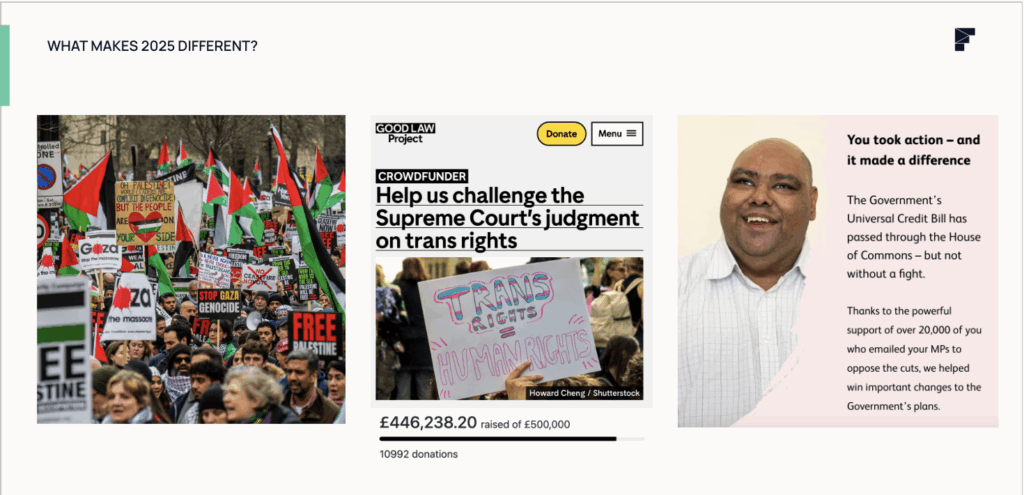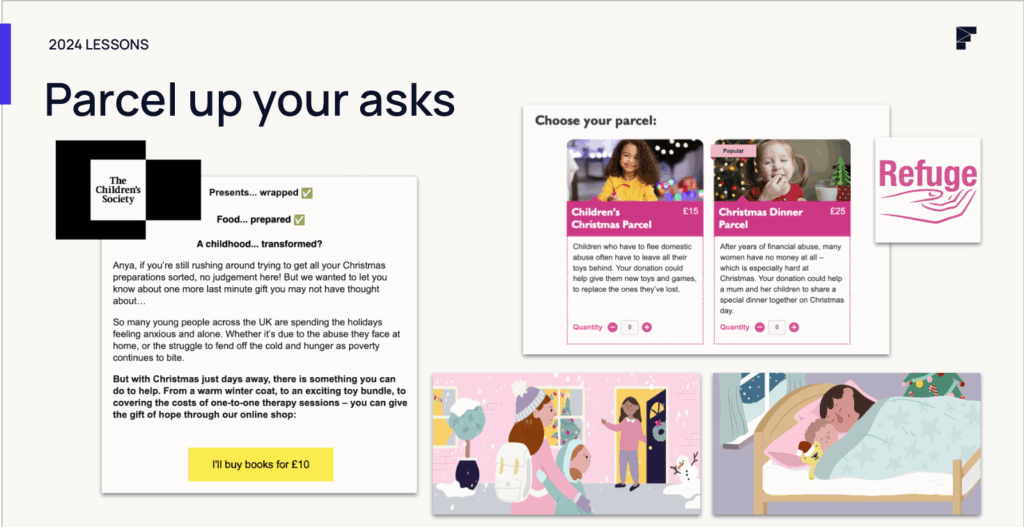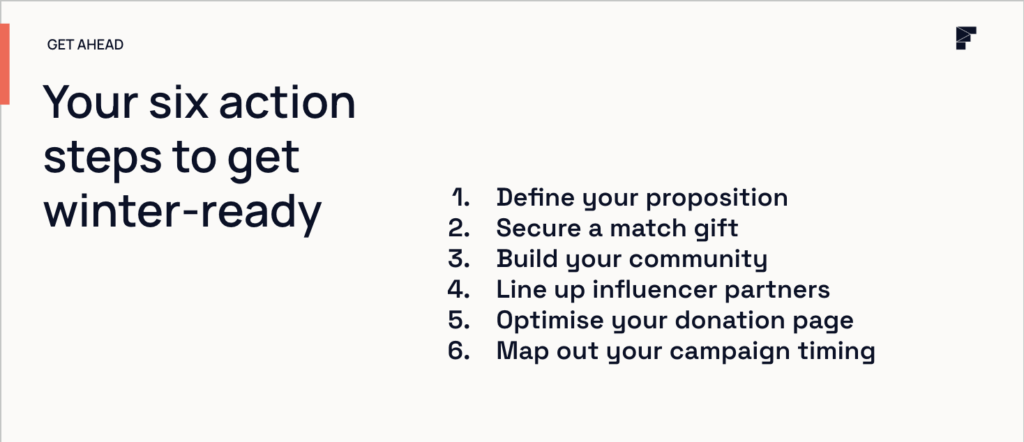Key takeaways and Q&A from our latest Forward Action webinar
Talking about Christmas in mid-July might feel premature. But if you want your winter fundraising campaign to hit its goals, the planning starts now. And in 2025, that early start has never been more important.
In our latest webinar, Christmas Come Early, we shared practical advice to help charities prepare, including insights from our 2024 campaigns and six steps for getting started. Whether you’re planning from scratch or refining last year’s strategy, here’s what you need to know.
Why 2025 is different
Let’s be honest – there’s a lot going on in 2025. The brutal conflict in Gaza is deeply troubling, while welfare cuts and rising inflation are all making life harder here too. Many supporters are struggling, emotionally and financially.
But amidst the headlines, we’re also seeing solidarity and people-powered momentum: ongoing protests for peace in Gaza, the surge in support for trans rights, and collective campaigning against disability cuts. Change feels urgent, and crucially, possible.

Your winter appeal can tap into this energy. Success this year lies in highlighting what’s at stake, and then showing your supporters they can do something to change it. With the right strategy, you can channel hopeful urgency into meaningful action.
The digital landscape is changing in 2025, so your tactics should evolve too. Now’s the time to get clued up about how AI is reshaping search. AI answers are shifting organic results and paid search ads, so your content needs to be discoverable in new ways. It also means experimenting with AI-driven tools within platforms like Meta to boost performance.
And don’t forget tried-and-tested methods that should be a priority in 2025: SMS can cut through crowded channels, connected TV can help you target emotionally resonant films in a cost-effective way, and influencers are a powerful way to reach new audiences.
Lessons from 2024: What worked
As well as looking forward, it’s important to look back at what’s worked before. We combed through data from last year’s campaigns and pulled out the key takeaways that you can carry into this year’s appeal:
Start strong – and early
Your launch matters. In 2024, we found that nearly 60% of total email income came from early emails, especially those with matched funding deadlines. Starting mid-November with a strong, sincere message makes a big difference.
Don’t underestimate your kicker
A well-timed kicker (a resend to non-openers with a slight twist) can outperform the original launch. One partner last year saw triple the income from a simple kicker email. It’s especially effective around crowded moments like Giving Tuesday.
Tell stories in unexpected ways
It’s time to mix up the predictable “case study > ask” structure. In 2024, what resonated most were stories told with rawness, honesty and a unique point of view. A surprising detail, an unexpected twist, or a real emotional response can really drive up response rates when tested against traditional asks.
Fix the weakest link: your donate page
Don’t let a clunky donate page be where your campaign falls down. Simplify copy, cut unnecessary form fields, and reduce visual clutter. A smooth, fast experience = more donations.
Parcel-up your ask
Use familiar festive formats to “parcel up” your donation prompts – without making it a restricted ask. Tailor options in emails based on past behaviour, and help supporters feel their gift is tangible and impactful.

Want the full list of tips?
What you should be doing now
There’s so much you can do to make 2025 an incredible year for your winter campaign, but if you’re not sure where to start, we shared a six steps for what to prioritise this summer:

1. Lock in your proposition
Get crystal clear on your campaign’s message. What’s the emotional heart of your appeal? What’s the truth that needs to be told? Find the story and framing that everything else will build from.
2. Secure matched funding
Matched gifts add urgency and boost conversion, especially when paired with a clear deadline. Reach out to major donors or trusts now to secure the support that can double donations later.
3. Fire up your community early
Start building momentum and emotional connection before you ask for money. WhatsApp groups have worked brilliantly for this, especially when paired with polls, voice notes, or short video updates. Consider how you’re engaging younger audiences too – TikTok and Instagram are key channels to reach this new wave of supporters.
4. Bring in influencers or public figures
Think about how you could involve talent to amplify your campaign. What kind of content would they create? Can you offer behind-the-scenes access or help them connect with your work in a meaningful way? If they align with your cause, they might even reduce or waive fees.
5. Optimise your donation journey
Now’s the time to test and improve. Where do people drop off? How long does it take to give? Your donate page deserves as much attention as your creative.
6. Map your campaign calendar
Plan out your key dates. When will you launch? What wider cultural or news moments could you hook into? How can you pace your comms to maintain energy and flexibility?
Want some help?
At Forward Action, we work on dozens of winter appeals every year. Whether you’re starting fresh or looking to elevate an existing strategy, we can help you find the heart of your message, craft standout creative, and build a campaign journey that converts.
Get in touch with us to start a conversation – or watch the full webinar replay here where we delve deeper into all of the above, and more.
Q&A
It was great to have so many questions within the webinar session and through our survey. We’ve done our best to capture and answer them below:
Q: You mentioned sending 6-10 emails being the best for performance. Were all of these sent as part of Christmas campaigns? What was the spacing between them and how many had a direct ask?
Yes, all of these emails were sent as part of Christmas campaigns – starting in November and sometimes going through to early January. This means they could be fairly spread out, but the key was having a variety of asks (the split is probably 60/40 between direct asks and engagement asks like polls, surveys etc) and looking for timely moments. We usually send around one email a week, but you might want to increase that to two or three for key moments like Giving Tuesday or if you had something to highlight like a matched funding deadline.
Q: And is there any data that shows how sending a higher volume of emails fairs over multiple years without tiring people out?
We haven’t seen major unsubscribes from taking this approach across multiple years, but there are a few things that can help prevent tiring people out. One is sending consistently high quality emails across the year that always consider what your audience is interested in, and make sure they are let in on the highs and lows of your work so the boost at Christmas continues to include emails they are happy to receive. Another is using exclusions in a smart way – for example excluding regular givers if you don’t want to overload them with asks. And finally keep growing your list – make sure across the year you’re building your list with new, highly motivated supporters so there are always people this will feel fresh to.
Q: Is there a time of day that hits the sweet spot for sending emails?
This is something to test with your own list. Traditionally early morning (e.g. 8am) has been the most effective time of day to send emails, and peak commuting time when people might be checking their phones.
Q: Is there a way to influence the AI search results so that our charity appears in the search summaries, especially as paid ads get pushed down the feed more and more?
With AI search results taking the top spot on our feeds, content strategy needs to shift from SEO (search engine optimisation) to AEO (answer engine optimisation). You can’t directly pay to be in these summaries, but you can increase the chance of being included in them by publishing content that directly answers queries like these. E.g. publish pages or blogs that answer specific questions around why people should donate to you at Christmas and the impact of donations at Christmas. FAQ style content is often scraped by AI summarisers, which prefer sites that are mentioned in trusted sources e.g. media coverage.
Q: For charities that take part in the Big Give, how would you recommend balancing that campaign with your own Christmas campaign?
Our partners usually make the Big Give the centre of their winter online appeal, and run surge email, paid ads and even direct mail around it. It can be a key part of your wider Christmas appeal if you make sure the messaging matches up and you let your supporters in on the fact this is a vital opportunity to raise extra funds.
Q: Will it be harder to cut through in the Black Friday buzz period on ads and emails as companies flood inboxes? Do you have any suggestions for standing out?
With the right approach, charities can still stand out. Lean into the contrast of commercial content by framing your message around giving rather than getting – positioning your appeal as a meaningful alternative to the sales frenzy. Use urgency with purpose, like a limited-time match fund, and consider sending things out at unusual hours, or with surprising asks for a charity – think really out-there subject lines, neon ads, a mini Black Friday appeal that wants to raise £X in 24 hours. Bold, values-led creative is the way, but don’t be afraid to take a few risks in these crowded moments.
Q: You talked about not going formulaic storytelling; problem, solution and ask for money. What do you suggest?
Formulaic storytelling can start to blur into the background, especially when every appeal follows the same arc. You still want to present the problem, solution and an ask, but to stand out, try leading with something unexpected – a surprising detail, a personal confession, or an unusual point of view. Email gives you the space to focus on small, unexpected details, like using unusual senders (a volunteer, frontline worker or supporter) can add authenticity and intrigue. Look for stories that don’t wrap up neatly or challenge assumptions – real, messy, human stories that spark curiosity and invite people to care. Perhaps a story that talks about the problem from a more rational, logical point of view – the perspective of the finance director trying to deliver services on a tight budget. The goal is to connect emotionally and make your audience feel something before you ask them to do something.
Q: What do you suggest for organisations that don’t have CTAs for communities to take?
If you don’t have a clear action for your community to take right now, focus on building engagement and emotional connection. Use your content to make people feel informed, included, and valued – through storytelling, behind-the-scenes insights, or even asking for their opinions or experiences. You can also invite people to reflect, share, or send a message of support, all to help create momentum and strengthen relationships ahead of future asks.
Q: We are not able to start our Christmas appeal on email until December due to comms restrictions in November. How would you suggest structuring an integrated campaign across email, direct mail and paid social from the beginning of December?
Our first suggestion would be to challenge this separation, and see if there’s a way to launch any sooner. Launching so late could ultimately cost your organisation money, and if your supporters are hearing inspiring stories or seeing your impact in November, then giving them an opportunity to donate as well makes a lot of sense.
But, if your Christmas appeal can’t launch via email until December, you can still build strong momentum by aligning channels early and planning smart sequencing. If you can, use paid social and direct mail earlier to warm-up your audiences, and once you can send emails, build urgency and reinforce your ask with direct donate asks. Including a deadline and a target can help if you’re short on time. Don’t be afraid to keep your asks going into January too as this can be a less crowded market.
Q: What would a budget for working with an influencer look like? No idea how much they charge.
Influencer costs can vary widely depending on their audience size, platform, engagement rate, and how aligned they are with your cause. For nano-influencers (under 10k followers), fees might start as low as £50, while someone with around 100k followers could charge anywhere from a few hundred to over £1,000. That said, if the influencer genuinely cares about your mission, they may be open to reduced rates or sometimes work pro-bono, but for influencers this is their job, so don’t go in expecting things for free. Authenticity is key, so prioritise creators whose values and content genuinely resonate with your audience over just reach.